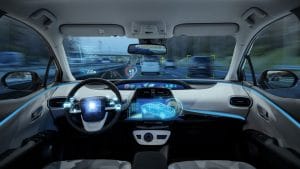Liability for Autonomous Vehicle Accidents in Austin
 Autonomous vehicles can already be seen on some Texas roads. The development of these self-driving cars may help the local economy through new manufacturing jobs, and self-driving cars may allow travelers to better use their time than focusing on traffic. There are dangers, though. Computer intelligence isn’t the same as human intelligence. Many traffic risks may be inherently easier for humans to recognize and react to than artificial intelligence systems.
Autonomous vehicles can already be seen on some Texas roads. The development of these self-driving cars may help the local economy through new manufacturing jobs, and self-driving cars may allow travelers to better use their time than focusing on traffic. There are dangers, though. Computer intelligence isn’t the same as human intelligence. Many traffic risks may be inherently easier for humans to recognize and react to than artificial intelligence systems.
At Slack Davis Sanger, our car accident lawyers are keeping current with the new developments in autonomous vehicle technology. We’re also keeping current on the reasons why manufacturers of autonomous vehicles and the computer technology used to run these vehicles should be held liable when accidents occur. We’re ready to file personal injury, product defect cases, and wrongful death claims whenever an autonomous vehicle causes injuries or causes a loved one to die.
Autonomous vehicle technology is already in Austin
According to KXAN, the City of Austin is already heavily involved in autonomous vehicle infrastructure. Autonomous vehicles built by Ford using Argo AI technology can already be seen in downtown and east Austin. The initial work included having a driver and an engineer in each autonomous vehicle sit in the car while the car monitors the streets to lay out a digital map of the city.
According to Kathleen Baireuther, a local Ford market manager, Ford’s vehicles have level four autonomy. At level one, there is no automation – the driver is completely in control. Level five is full autonomy – the computer technology is completely in control. Level four, Ford’s vehicles, means that the car does not require a driver in specific preapproved areas. As of the date of the KXAN article, Ford continues to have human drivers in their autonomous vehicles.
KXAN also reported that the City of Austin is working on several initiatives to help better accommodate autonomous vehicles, such as the implementation of a Public Infrastructure Network Node (PINN) system:
A PINN network could be built into already existing traffic poles. It would combine technology like putting a CD player, a camera and an iPod into an iPhone. “It’s like putting these technologies into a single point to collect everything from atmospheric data to providing access to the internet,” said Robert Spillar, City of Austin Transportation director.
Current autonomous vehicle statistics
According to Policy Advice, more than half of small businesses think that they will have an autonomous fleet of vehicles in the next 20 years. More than 80 companies, as of April 2021, are already working on autonomous vehicles. However, even if cars were fully autonomous, more than 70 percent of drivers say they would miss driving to some degree.
There have already been several deaths attributed to autonomous vehicles at different levels of autonomy, according to Forbes. These include Tesla’s AutoPilot, a Level 3 autonomous vehicle, and Uber’s self-driving car, which is between a Level 4 and Level 5 autonomous vehicle.
Who is liable for autonomous vehicle accidents?
Since autonomous vehicle technology is fairly new, there aren’t many laws that regulate liability for accidents. According to The Drive, Texas does permit autonomous vehicles, provided they follow specific rules. The companies “must carry a specified amount of insurance, and must accept liability for any incidents.” Self-driving cars also must be able to record video. Texas, unlike many other states, does not explicitly state that a human operator be in the car.
Like most car accidents, the right to hold responsible defendants liable for your injuries depends on current common law. Common law is essentially the law as determined by the courts. The main theories of liability in autonomous vehicle cases are expected to fall under personal injury law and product liability law. There are a lot of factors regarding liability that will likely be resolved only when enough court cases are decided.
One factor is the level of autonomy of the vehicle. The National Highway Traffic Safety Administration (NHTSA) defines the current levels of autonomy. States like Texas may have their own definitions.
Another factor is that the police will still need to be called to the scene of the accident. If the autonomous vehicle does not have a human driver, then the police will essentially have to interact with the vehicle’s communication system to obtain the relevant insurance information. This information should identify the owner of the vehicle. Police will also need to identify the type of car so the identity of the manufacturer can be determined.
More about car accidents and liability
Personal injury cases are based on the premise that the driver, vehicle owner, or car manufacturer are liable for damages if they are negligent.
- The driver. In a fully autonomous vehicle, a human does not drive the vehicle. In lower-level autonomy cars, a human either drives the vehicle or is responsible for taking over control of the vehicle when necessary to avoid accidents. States will likely (if they haven’t already) need to identify who the driver is. The driver could be the person who is sitting in the driver’s seat as the driver. The driver could be the person who starts the technology so the car can travel. The driver could be someone who is designated as the person to respond in case of an autonomous failure.
- The car owner. Car owners are generally liable for the negligence of their driver – if there is a driver. Whether car owners can be found liable if the vehicle does not have a human driver is not clear at the present time. Legislatures will likely need to set the standards for determining the liability of owners. Otherwise, the courts will have to decide on a case-by-case basis.
- The manufacturer. Manufacturers can be held liable when their products malfunction on a theory of negligence. This requires showing that the manufacturer specifically failed to do something it should have (like conduct quality tests) or did something it shouldn’t have.
Employers could also be held liable if an employee causes an accident. The one advantage of autonomous cars that manufacturers like to tout is that autonomous vehicles can’t drive while intoxicated. So, there’s no concern that a tavern or seller of alcohol might be liable for an autonomous vehicle accident.
In product liability cases, manufacturers of the vehicle, the manufacturers of the hardware, and the software designers could be held liable if their products are defective and the defect causes the accident.
Some states, however, are providing that original manufacturers may not be liable if the accident is caused by the installation of hardware or software loaded after the original is installed, or if the hardware/software is added to a vehicle that was not previously autonomous.
In wrongful death cases, the family can file liability claims based on either personal injury or product liability.
At Slack Davis Sanger, our Texas car accident lawyers are keeping current with the technology and legal developments affecting autonomous vehicles. We have a strong track record of success negotiating high settlements and obtaining strong verdicts in car accident accidents. Our lawyers are ready for the unique challenges of autonomous vehicle litigation. To discuss how to file any type of car accident claim, with an experienced Austin, Dallas, or Fort Worth lawyer, please call us at 800-455-8686 or use our contact form to schedule an appointment.

The firm handles cases involving catastrophic personal injuries and deaths. Our work spans three decades of handling airplane and helicopter crashes, truck and car accidents, oilfield and construction accidents, and other devastating accidents. We try lawsuits throughout the country in both federal and state courts and have recovered hundreds of millions of dollars for our clients. To date, we have handled or tried cases in 47 states, read more about our attorneys and firm.
